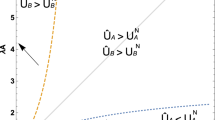Abstract
We study the impact of public good spillovers on tax competition between two imperfectly integrated countries with different levels of productivity. We show that international public good spillovers, by reducing the tax gap between countries, strengthen the agglomeration of firms in the most productive country. Then we carry on a welfare analysis. We first assume that governments are engaged in a redistributive tax policy. At the non-cooperative equilibrium, the tax level in the high-productivity country is inefficiently high while it is inefficiently low in the other country. A different conclusion emerges when tax revenues are recycled in a public good provision: taxes are inefficiently low in both countries and public good spillovers increase the global welfare. Finally, for a given amount of total tax revenues, public good provision in the high-productivity country is inefficiently high compared to its level in the low-productivity country.
Similar content being viewed by others
References
Baldwin, R. E., & Krugman, P. (2004). Agglomeration, integration and tax harmonisation. European Economic Review, 48, 1–23.
Bergstrom, T., Blume, L., & Varian, H. R. (1986). On the private provision of public goods. Journal of Public Economics, 29(1), 25–49.
Bjorvatn, K., & Schjelderup, G. (2002). Tax competition and international public goods. International Tax and Public Finance, 9, 111–120.
Bloch, F., & Zenginobuz, Ü. (2006). Tiebout equilibria in local public goods economies with spillovers. Journal of Public Economics, 90, 1745–1763.
Brander, J. A., & Krugman, P. (1983). A reciprocal dumping model of international trade. Journal of International Economics, 15, 313–323.
Bucovetsky, S. (1991). Asymmetric tax competition. Journal of Urban Economics, 30, 167–181.
Combes, P. P., & Overman, H. G. (2005). The spatial distribution of economic activities in the European Union. In Henderson V. & J. F. Thisse (Eds.).
Dixit, A. K. (1979). A model of duopoly suggesting a theory of entry barriers. Bell Journal of Economics, 10, 2032.
Gaigné, C., & Riou, S. (2007). Globalization, asymmetric tax competition and fiscal equalization. Journal of Public Economic Theory, 9(5), 901–925.
Haufler, A., & Wooton, I. (2007). Competition for firms in an oligopolistic industry: do firms or countries have to pay? (CESifo Working Paper Series No. 1976).
Head, K., & Mayer, T. (2000). Non-Europe: the magnitude and causes of market fragmentation in the EU. Weltwirtschaftliches Archiv, 136(2), 285–314.
Keen, M., & Marchand, M. (1997). Fiscal competition and the pattern of public spending. Journal of Public Economics, 66, 33–53.
Kind, H., Midelfart Knarvik, K., & Schjelderup, G. (2000). Competing for capital in a ‘lumpy’ world. Journal of Public Economics, 78, 253–274.
Kobayashi, Y., Kunizaki, M., & Nakamura, K. (2003). Pareto improvement rules of public spending coordination under fiscal competition (Working Paper).
Köthenbürger, M. (2002). Tax competition and fiscal equalization. International Tax and Public Finance, 9, 391–408.
Ludema, R., & Wooton, I. (2000). Economic geography and the fiscal effects of regional integration. Journal of International Economics, 52, 331–357.
Matsumoto, M. (2000). A note on the composition of public expenditure under capital tax competition. International Tax and Public Finance, 7, 691–697.
Oates, W. E. (1972). Fiscal federalism. San Diego: Harcourt Brace Jovanovich.
Ottaviano, G., & Thisse, J.-F. (2004). Agglomeration and economic geography. In J. V. Henderson & J. F. Thisse (Eds.), Handbook of regional ad urban economics (Vol. IV, pp. 2564–2608). Amsterdam: North-Holland.
Ottaviano, G., & van Ypersele, T. (2005). Market size and tax competition. Journal of International Economics, 67, 25–46.
Ottaviano, G., Tabuchi, T., & Thisse, J.-F. (2002). Agglomeration and trade revisited. International Economic Review, 43, 409–436.
Persson, T., & Tabellini, G. (1992). The politics of 1992: fiscal policy and European integration. Review of Economic Studies, 59, 689–701.
Picard, P., Thisse, J.-F., & Toulemonde, E. (2004). Economic geography and the distribution of profits. Journal of Urban Economics, 56(1), 144–167.
Vives, X. (1990). Trade association disclosure rules, incentives to share information, and welfare. Rand Journal of Economics, 21, 40930.
Warr, P. (1983). The private provision of a public good is independent of the distribution of income. Economic Letters, 13, 207–211.
Wildasin, D. E. (1989). Interjurisdictional capital mobility: fiscal externality and a positive subsidy. Journal of Urban Economics, 25(2), 193–212.
Wilson, J. (1991). Tax competition with interregional differences in factor endowments. Regional Science and Urban Economics, 21, 423–452.
Wilson, J. (1999). Theories of tax competition. National Tax Journal, 52(2), 269–304.
Zodrow, G. (2003). Tax competition and tax coordination in the European Union. International Tax and Public Finance, 10, 651–671.
Zodrow, G., & Mieszkowski, P. (1986). Pigou, Tiebout, property taxation and the underprovision of local public goods. Journal of Urban Economics, 19, 356–370.
Author information
Authors and Affiliations
Corresponding author
Rights and permissions
About this article
Cite this article
Exbrayat, N., Madiès, T. & Riou, S. International tax competition: do public good spillovers matter?. Int Tax Public Finance 17, 479–500 (2010). https://doi.org/10.1007/s10797-009-9122-3
Received:
Accepted:
Published:
Issue Date:
DOI: https://doi.org/10.1007/s10797-009-9122-3




